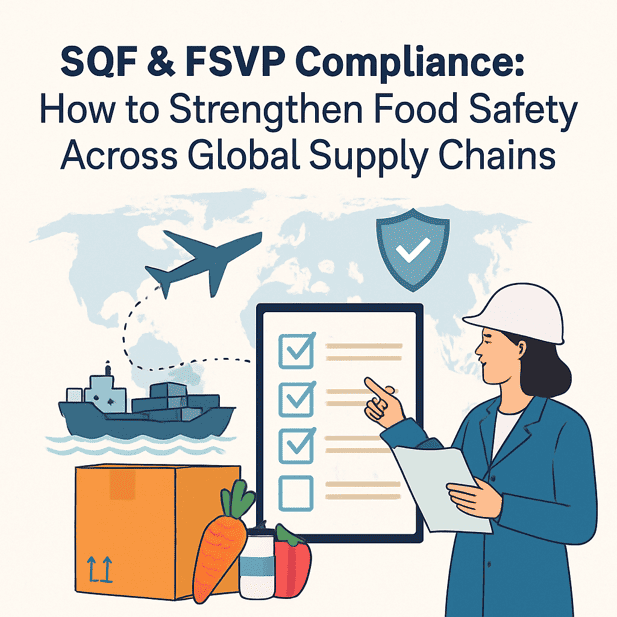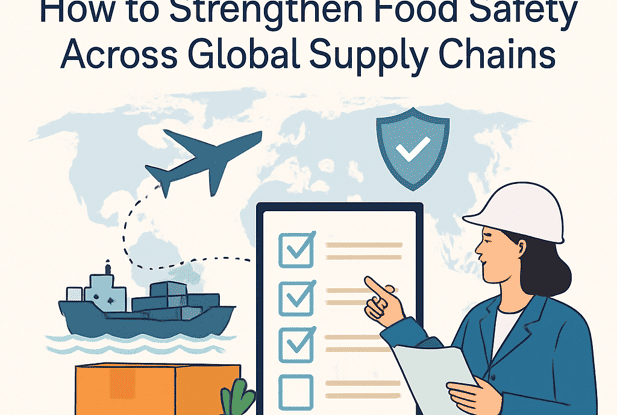SQF And FSVP Compliance: How to Strengthen Food Safety Across Global Supply Chains
SQF And FSVP Compliance: How to Strengthen Food Safety Across Global Supply Chains
How SQF Certification and FSVP Requirements Create a Safer Food Supply Chain
In today’s global food marketplace, ensuring product safety across international supply chains has never been more critical. Two pivotal frameworks stand at the forefront of this mission: Safe Quality Food (SQF) certification and the Foreign Supplier Verification Program (FSVP). Together, they create a comprehensive approach to food safety that protects consumers and empowers businesses to maintain compliance with increasingly stringent regulations.
Food safety isn’t just about regulatory checkboxes. It’s about trust, brand protection, and public health.
This guide explores how SQF and FSVP work in tandem to strengthen your supply chain integrity and meet FDA requirements. Whether you’re a food importer, manufacturer, or retailer, understanding these complementary programs is essential to your operation’s success in the global marketplace.
Understanding SQF Certification: The Foundation of Food Safety Excellence

What Is SQF Certification?
SQF (Safe Quality Food) represents one of the most respected and widely recognized food safety certification programs globally. Administered by the SQF Institute, this certification demonstrates that a food producer or manufacturer has implemented rigorous food safety control systems that meet international standards.
The SQF program follows the benchmarks established by the Global Food Safety Initiative (GFSI) and covers all aspects of food production, processing, and distribution.
“SQF certification doesn’t just signal compliance – it represents a comprehensive commitment to food safety excellence throughout every production stage,” notes many industry experts.
The Three Levels of SQF Certification
SQF certification operates on a tiered system that allows businesses to implement food safety measures appropriate to their operations:
1. SQF Food Safety Fundamentals (Level 1) – Entry-level certification focused on implementing basic food safety controls.
2. SQF Food Safety Code (Level 2) – Comprehensive food safety management system with HACCP-based controls.
3. SQF Quality Code (Level 3) – Advanced quality management systems that go beyond safety to address quality concerns.
This progressive approach allows companies to build their food safety programs methodically, ensuring a strong foundation before progressing to more complex requirements.
>>> See More: FDA Red 3 Ban: Compliance Deadlines & Reformulation Strategies for Manufacturers
The Foreign Supplier Verification Program (FSVP): Securing International Supply Chains
FSVP Requirements and Implementation
The FDA’s Foreign Supplier Verification Program represents a fundamental shift in how imported foods are regulated in the United States. Unlike previous approaches that relied heavily on point-of-entry inspection, FSVP places responsibility on U.S. importers to verify that their foreign suppliers comply with FDA safety standards.
This verification isn’t a one-time event. It requires ongoing assessment and monitoring.
FSVP compliance requires importers to:
– Conduct hazard analyses for each food
– Evaluate potential supplier risks
– Determine appropriate verification activities
– Perform supplier verification
– Take corrective actions when necessary
– Maintain comprehensive records
“FSVP shifts the paradigm from reactive to proactive food safety management,” emphasizes food safety experts across the industry.
>>> See More: AMS and US ACE: Complete Guide to Automated Manifest System and Customs Environment
Who Must Comply with FSVP?
The FSVP regulations apply to the U.S. owner or consignee of a food offered for import into the United States. If there is no U.S. owner or consignee at the time of entry, the FSVP importer is the U.S. agent or representative of the foreign owner, as confirmed at the time of entry.
There are some exemptions, including certain juice and seafood products covered by HACCP regulations, and foods imported for research or personal consumption.
The Powerful Synergy Between SQF and FSVP
How SQF Certification Supports FSVP Compliance
One of the most significant advantages for food businesses is how SQF certification can streamline FSVP compliance. When your foreign suppliers hold valid SQF certification, you have strong evidence that they’re maintaining robust food safety systems aligned with FDA expectations.
SQF certification provides documented evidence of:
– Systematic hazard analysis
– Preventive controls implementation
– Ongoing monitoring procedures
– Verification activities
– Corrective action protocols
These elements directly correspond to FSVP requirements, creating natural alignment between the two programs.
Streamlining Documentation and Reducing Duplication
Food safety compliance often creates documentation challenges. The integration of SQF and FSVP offers strategic opportunities to reduce redundancy.
When working with SQF-certified suppliers, importers can leverage existing certification documentation to satisfy many FSVP requirements. This approach:
– Reduces administrative burden
– Minimizes duplication of efforts
– Creates consistent expectations across the supply chain
– Facilitates clearer communication between trading partners
>>> See More: Import Alert 99-32: Understanding FDA Inspection Refusal Consequences and Solutions
Implementing an Integrated SQF and FSVP Approach
Step-by-Step Implementation Guide
Building an integrated SQF and FSVP compliance system requires thoughtful planning and execution:
1. Map Your Supply Chain – Identify all suppliers, ingredients, and products within scope.
2. Risk Assessment – Categorize suppliers based on food safety risk levels.
3. Leverage SQF Documentation – For SQF-certified suppliers, determine which certification elements fulfill FSVP requirements.
4. Gap Analysis – Identify any FSVP requirements not addressed by existing SQF documentation.
5. Develop Verification Procedures – Create protocols for ongoing supplier verification.
6. Document Management System – Establish systematic records maintenance for both programs.
7. Training – Ensure all relevant personnel understand both SQF and FSVP requirements.
This methodical approach ensures comprehensive compliance while maximizing efficiency.
Benefits Beyond Compliance: The Business Case for SQF and FSVP Integration
The integration of SQF certification and FSVP compliance delivers benefits extending far beyond regulatory requirements:
– Enhanced Brand Protection – Comprehensive food safety systems reduce the risk of contamination incidents that could damage brand reputation.
– Improved Supplier Relationships – Clear, consistent expectations strengthen supplier partnerships.
– Reduced Costs – Preventing food safety failures is invariably less expensive than responding to them.
– Market Access – SQF certification often serves as a prerequisite for access to major retailers and food service customers.
– Continuous Improvement – Both programs emphasize ongoing enhancement of food safety systems.
Conclusion: The Future of Global Food Safety Management
The integration of SQF certification and FSVP compliance represents the evolution of food safety management in global supply chains. As international food trade continues to grow, these complementary frameworks provide a roadmap for ensuring product safety regardless of origin.
For food businesses operating in today’s complex regulatory environment, understanding how these programs work together isn’t just about compliance—it’s a strategic advantage. By leveraging the natural alignment between SQF and FSVP, companies can build more resilient supply chains, protect consumers, and strengthen their position in the marketplace.
The future of food safety lies in these integrated approaches that combine the best elements of private certification and regulatory oversight. Companies that master this integration will be well-positioned to thrive in the increasingly complex world of global food production and distribution.
By embracing both SQF certification and FSVP compliance, food businesses don’t just meet today’s requirements—they prepare for tomorrow’s challenges in ensuring the safety of our global food supply.



